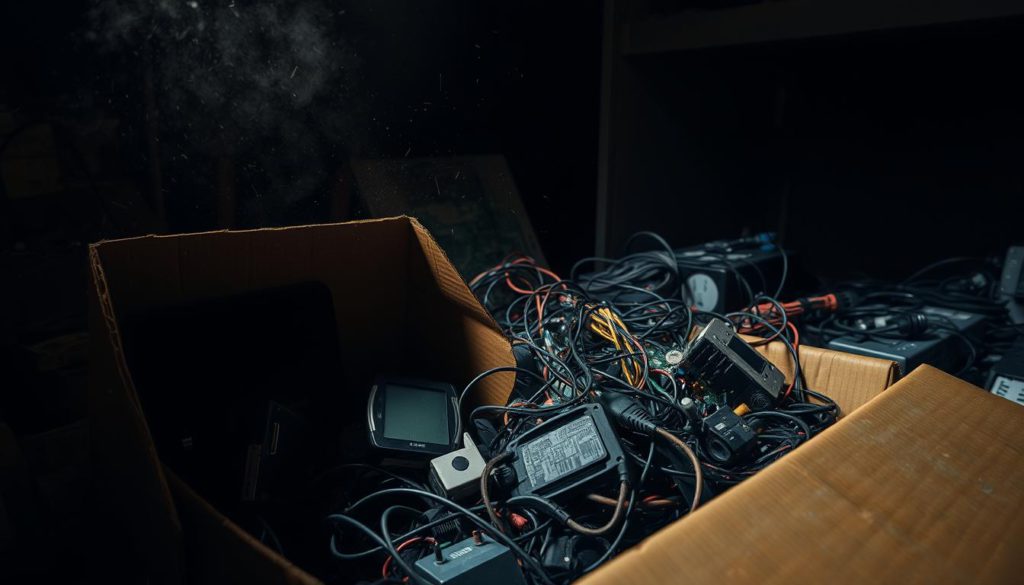You’ve carefully tucked away old phones, spare laptops, or holiday gadgets – but dust, humidity, and heat might be sabotaging them as you read this. Electronics degrade faster when stored incorrectly, losing value and functionality. A single cracked screen or corroded battery could turn your $500 tablet into clutter.
Why does this happen? Devices accumulate static-attracting dust when left exposed. Moisture creeps into ports, inviting rust. Even “safe” spots like attics or garages often have temperature swings that warp circuits. But here’s the good news: With a few proactive steps, you can shield your gear from these invisible threats.
Start by wiping devices with a lint-free cloth – residue attracts grime. Remove batteries to prevent leaks. Original packaging isn’t just for resale value; its custom foam blocks impacts. Label cables to avoid tangles later. These habits add minutes to your process but save hundreds in replacements.
Key Takeaways
- Clean all surfaces thoroughly before storage to prevent dust buildup
- Disconnect and organize cords to avoid stress on ports
- Use anti-static materials like bubble wrap for fragile components
- Store in climate-controlled areas away from direct sunlight
- Remove batteries to minimize corrosion risks
- Keep original boxes for ideal protective sizing
- Label containers clearly for quick identification
Understanding the Risks and Benefits of Proper Electronic Storage

Your unused devices might be deteriorating faster than you think due to common storage errors. Environmental factors and everyday oversights can silently degrade screens, circuits, and batteries. By recognizing these threats, you’ll preserve functionality and avoid costly replacements.
Environmental Threats to Your Gear
Three invisible enemies attack stored electronics: temperature swings, humidity spikes, and dust accumulation. Heat warps circuit boards, while cold makes plastic brittle. Moisture creeps into ports, causing corrosion that’s often invisible until power buttons stop working.
| Factor | Risk Level | Prevention Tip |
|---|---|---|
| High Humidity | Severe | Use silica gel packets |
| Dust Buildup | Moderate | Anti-static cloth wraps |
| Temperature Swings | Critical | Climate-controlled spaces |
Storage Myths That Cost You Money
Many assume any dry spot works for electronics. Wrong. Storing devices in basements invites moisture damage. Leaving batteries inside risks acid leaks. Plastic wrap might seem protective but traps condensation.
“Sealing gadgets in airtight containers without desiccants is like locking them in a steam room.”
Another costly mistake? Using newspaper instead of bubble wrap. Ink transfers onto surfaces, and paper offers zero static protection. Label those cables – tangled cords stress ports when you yank them later.
How to Store Unused Electronics to Avoid Damage: A Step-by-Step Guide

Follow this systematic approach to protect your gear during downtime. Proper preparation prevents hidden threats like oxidation or data loss while keeping components ready for future use.
Preparing Your Devices: Cleaning and Disassembling
Start by backing up files from phones, tablets, and computers. Use cloud services or external drives to safeguard photos, documents, and settings. Power down each device completely before handling.
Remove all detachable parts: batteries, SIM cards, and memory cards. Wipe screens and keyboards with microfiber cloths. For crevices, blast compressed air at 45-degree angles to dislodge crumbs without pushing debris deeper.
Proper Wrapping, Labeling, and Packing Techniques
Wrap individual components in anti-static bubble wrap. Avoid regular plastic bags – they trap moisture. Place small accessories like chargers in labeled ziplock bags first for double protection.
Use original boxes whenever possible. Their custom-fit foam inserts prevent shifting during moves. For non-original containers, line the bottom with packing peanuts before adding devices. Mark boxes with contents and dates using waterproof markers.
Store cables separately in coiled positions. Secure them with velcro ties instead of rubber bands, which degrade over time. This prevents port damage when retrieving devices later.
Climate-Controlled Storage and Protective Maintenance Tips

Preserving your gear requires more than just tossing it in a closet. Climate-controlled environments and strategic packing methods combat the twin threats of environmental shifts and physical wear. Let’s explore solutions that go beyond basic storage.
Choosing a Secure, Climate-Controlled Facility
Not all storage units protect equally. Prioritize facilities maintaining 55-80°F temperatures and 40-50% humidity levels – ideal ranges for electronics. Look for these security features:
| Feature | Benefit | Top Providers |
|---|---|---|
| 24/7 Temperature Monitoring | Prevents condensation | Public Storage, Extra Space |
| Biometric Access | Blocks unauthorized entry | CubeSmart |
| Impact-Resistant Walls | Reduces physical shocks | Life Storage |
Cheaper units might lack humidity sensors or backup power for climate systems. One facility manager notes: “Devices stored in standard units show 3x more corrosion after six months.”
Utilizing Original Packaging and Additional Accessories
Manufacturer boxes aren’t just marketing – their foam molds absorb shocks better than generic padding. If original packaging is unavailable, use anti-static bubble wrap and silica gel packs. Label each box with contents and expiration dates for batteries.
For long-term storage, schedule quarterly checks. Inspect seals for cracks and test moisture absorbers. Rotate devices with built-in batteries every 90 days to prevent capacity loss. Keep cables in separate, labeled pouches to avoid port strain during retrieval.
Investing in proper storage now saves money later. A climate-controlled unit costing $150/month protects $2,000 worth of gear – far cheaper than replacing water-damaged laptops or data-corrupted drives.
Conclusion
Properly stored devices retain value and function, but common mistakes undo both. Start by cleaning components thoroughly and removing batteries to prevent corrosion. Use original boxes or anti-static wraps for fragile parts—these materials shield against dust and physical damage.
Always choose a climate-controlled unit with stable humidity levels. This prevents moisture buildup that warps circuits over time. Label cords and accessories clearly to avoid port strain during retrieval.
Regularly inspect stored items, especially those with lithium-ion batteries. Update your strategy as seasons change—summer heat demands different precautions than winter dryness. Whether keeping gear for months or years, these steps ensure your electronics stay functional when needed.
Review your current setup today. Small adjustments now save costly repairs later.
FAQ
Should I remove batteries before storing electronics?
Yes. Leaving batteries inside devices can lead to corrosion or leaks over time. For lithium-ion batteries, discharge them to 50% before storage to prolong lifespan. Store loose batteries separately in anti-static bags.
Can dust damage electronics during long-term storage?
Absolutely. Dust buildup can clog vents, trap moisture, and cause overheating. Use compressed air to clean ports and fans, then seal devices in anti-static bags or airtight containers like Ziploc’s Space Bags.
Are climate-controlled storage units worth the cost?
For sensitive items like cameras or gaming consoles, climate control prevents damage from humidity and temperature swings. Facilities like Public Storage offer units maintaining 55-85°F and 40-50% humidity—ideal for electronics.
Is original packaging necessary for safe storage?
While not mandatory, original boxes (like Apple’s iPhone packaging) provide custom-fit protection. If unavailable, use sturdy containers with bubble wrap or foam inserts. Label boxes clearly to avoid accidental mishandling.
How do I prevent moisture damage in stored devices?
Add silica gel packs (available on Amazon) to absorb excess humidity. Avoid plastic wrap directly on screens—it traps condensation. Opt for breathable materials like cotton cloth for wrapping monitors or TVs.
Should I label cables and accessories separately?
Yes. Use color-coded tags or label makers like Brother’s PTouch Cube. Bundle cords with Velcro straps and store them in zippered pouches. This saves time when reconnecting devices later.
How often should I check stored electronics?
Inspect items every 3-6 months. Look for signs of pests, moisture, or battery swelling. Power on devices briefly to ensure functionality. Update backups (like iCloud or Google Drive) if accessing stored data.
